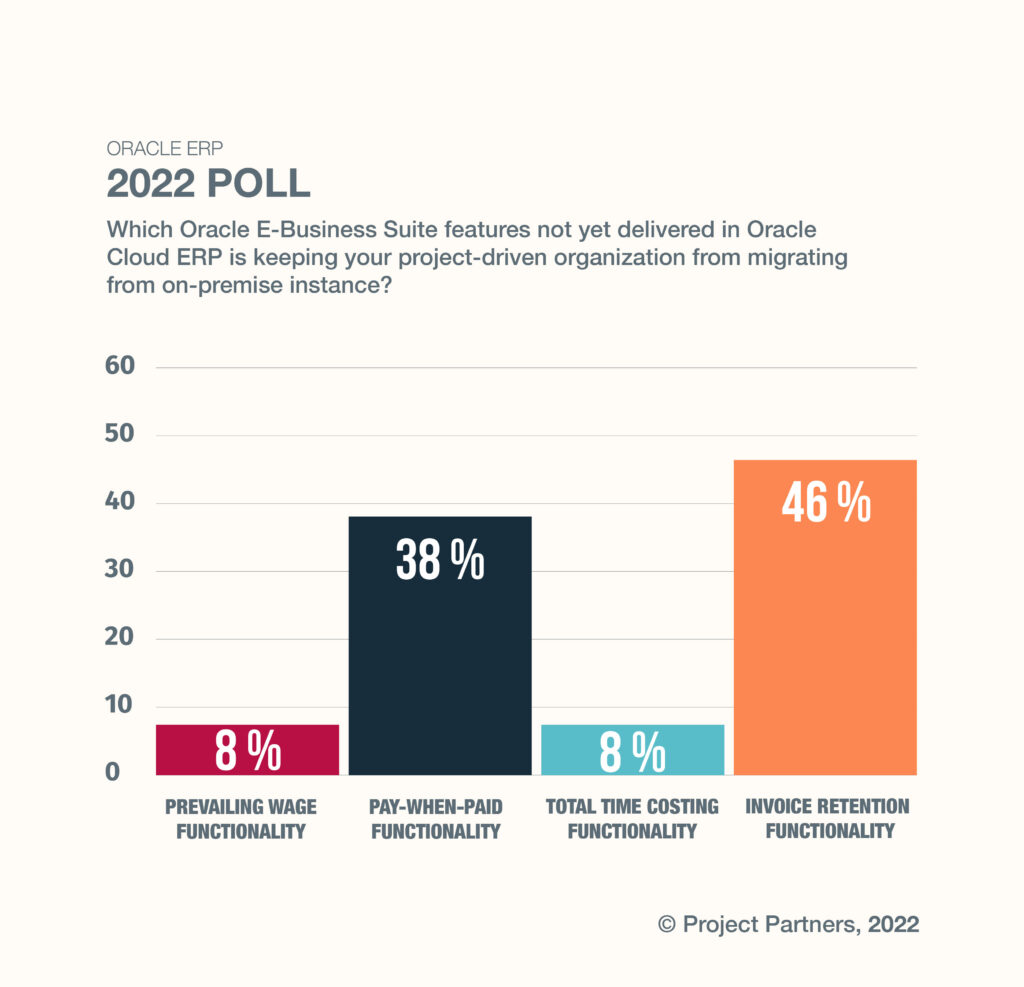In this two-part blog series, our experts will uncover the critical differences between Oracle E-Business Suite (EBS) and Oracle Cloud ERP and whether you should continue to utilize your current technology ecosystem or migrate to the Cloud. In this blog, we will dive deep into the feature and benefit differences between the two solutions. If you missed it, click here to read part one.
What does Oracle EBS support that ERP Cloud does not, and how can I rectify this when we choose to migrate?
Specifically, within the Oracle Projects realm, several features have yet to be delivered:
- Total Time Costing
- Prevailing Wage(Davis Bacon Act)
- Paid When Paid Hold Management
- Contingent Worker Functionality
- Invoice Retention
- Billing for Government Contracting
- And others spanning across industries
A Recent Poll
In a recent poll we conducted on LinkedIn, we asked our listeners: which Oracle EBS Features not yet delivered are holding your organization back from migrating to the Cloud? We chose four functionalities out of the list above that are not yet offered on Oracle Cloud ERP, and here’s what you had to say:

Good news! When dealing with business processes that are not supported due to functionality not present in the Cloud, PaaS solutions can be leveraged to address them. Project Partners has developed PaaS Pre-Built Solutions to fill the gaps in Oracle Fusion Cloud.
Contact our experts here if you are interested in learning more about Project Partners’ Pre-Built Solutions.
What’s The Difference Between Oracle EBS and Oracle Cloud ERP?
Many project-driven organizations using Oracle EBS are starting to be branded using a “legacy” technology. However, with many customizations to their on-premise environment, completing a digital transformation to the Cloud can seem out of reach. Oracle EBS is still, in fact, a viable solution. However, this technology might fade into not aligning with your organization’s long-term strategy moving into 2023 and beyond.
The Ultimate Cheat Sheet – A Side-By-Side Comparison
We’ve created a side-by-side feature/benefit analysis for you to view and consider:
| Feature/Benefit | Oracle E-Business Suite | Oracle Cloud ERP |
| Internal Update Efforts | Each patch update has to be managed by the Customer (You). | Oracle manages each patch update via Quarterly Release Patches. It still requires the Customers to test the existing implemented solution to ensure a solution to business process alignment. |
| Pricing Model/Cost Effectiveness | The licensed Based/Maintenance Cost model combined with a Customer-driven Patching/Upgrade model is less cost-effective than Cloud ERP. It is the customer’s responsibility to ensure patching and upgrades are done on time. | A Subscription-Based model with no hardware costs as instances is hosted by Oracle. This approach is more cost-effective because the product is upgraded every quarter to ensure the Customer is on the latest version. |
| Licensing Cost & Maintenance | A Licensing and Annual Maintenance cost. | A Subscription-based Model that includes maintenance costs. |
| Integration and Infrastructure Capabilities (Native and 3rd Party) | Integrations and Extensions are supported. Integrations can leverage delivered APIs to integrate data from 3rd party systems. Native integration is provided as part of out-of-the-box functionality for Oracle Applications. Custom integrations can be developed to support those instances when a native integration is not available. | Integrations can be handled as PaaS-based solutions leveraging delivered REST APIs to integrate with 3rd party systems. Native integration is provided as part of out-of-the-box functionality for Oracle Applications. On those rare occasions where native integration is not available, PaaS integrations can be leveraged. |
| Architecture | On-Prem Model | SaaS Architected Model |
| Ease of Use | Ease of use is driven by two factors: 1) The quality of the implementation; 2) the quality of training. However, since EBS is legacy, the user interface can seem outdated in comparison. | Offers user interface tailorability to meet specific customer needs, thus improving the overall user experience. |
| User Interface Platform | GUI and Web Based | Web Based |
| Scalability | Both models are fully scalable. | The key difference lies within the Quarterly Update process that ensures clients are always on the current release of the product to stay current and competitive in today’s and tomorrow’s industry landscape. |
| Time & Effort to Implement | It is important to remember that every implementation is different, and applying a standard estimate for implementation effort and duration is difficult. However, some key factors driving the implementation are complexity and the number of customizations. | Based on the business process-driven design, the implementation time will be quicker. However, it is important to remember the complexity of solution design will drive implementation effort and duration. |
| Functionality | Both models offer comparable levels of functionality. As previously noted, it is essential to note that some functionality in EBS is not currently available in Oracle Cloud ERP, which can be addressed via PaaS solutions. | There are improvements in Oracle ERP Cloud that are not available in Oracle EBS. |
To Conclude
Either continuing to utilize your existing or enhancing your current Oracle EBS investment or beginning to take steps to migrate to Oracle Cloud ERP is not a small choice to make.
Taking everything into consideration, if you have more questions regarding the effectiveness of your existing project technology and business processes, Project Partners offers a full-service Assessment – providing a reliable, cross-functional roadmap that will help point you in the direction that best suits your organization’s existing and future goals.
About the Author

Bruce Maghan is Project Partners Senior Oracle Applications Consultant with 14+ years of experience implementing and using the Oracle Projects Suite of applications. Combines this experience with a 13-year Project Controls background in the Power, Marine, and Construction Maintenance industries to possess a full understanding of business processes and the ability to apply technical solutions.
Bruce’s experience includes: Oracle Applications releases 11 & 12, Oracle Fusion/Cloud Project Portfolio Management training, business process design improvements, Functional Lead over all Projects modules, custom SLA rules design, multi-org implementations, multi-ledgers implementations, multi-ledgers implementations, multi-currency implementations, and contract services integration between Purchasing, Payables, OTL, and Projects.